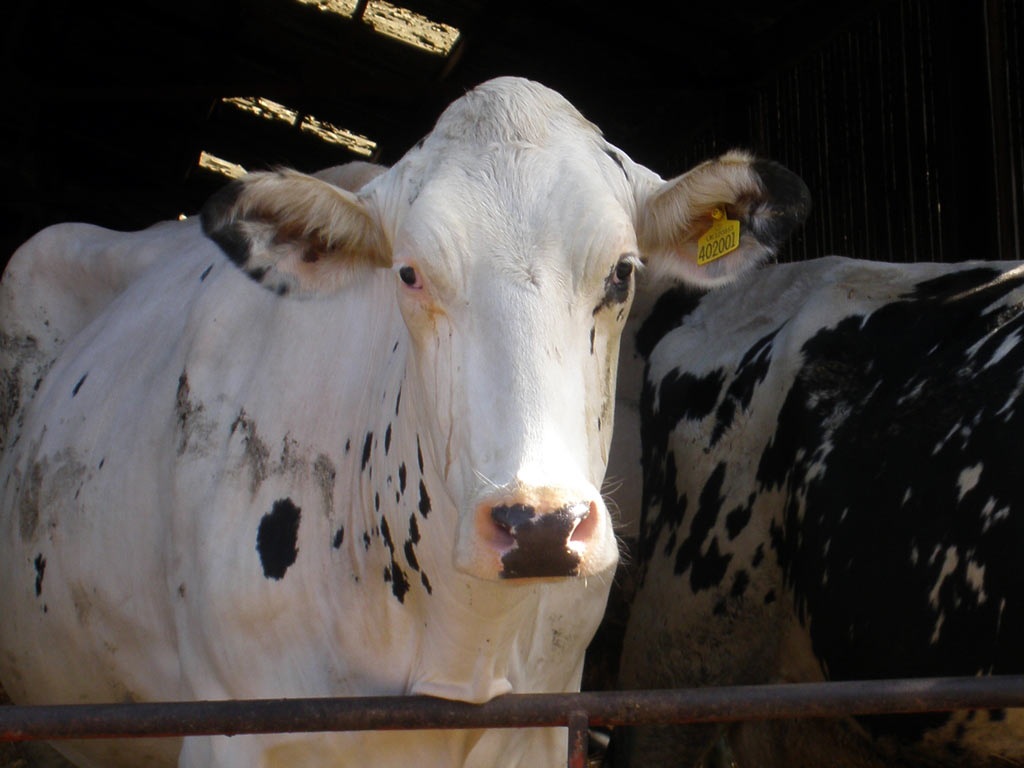
Hi-Pro Soya meal vs Rape seed meal.
There are a few different versions of Soya and Rape seed meals available to the UK farming industry.
In order to focus the pros and cons of the debate, I have chosen to restrict the comparison to Hi-Pro Soya and both Extracted Rapeseed meal and Expeller Rapeseed meal.
“They say you can prove anything with figures!”
How should we evaluate the three products?
The key features of the products which have a direct effect on dairy production are as follows: –
- The Dry Matter (%DM, the same for all three).
- The Crude Protein. (CP % DM)
- The Energy. (MJ/Kg DM)
- The Bi-Pass Protein. (% DM) (contains essential Bi-pass amino acids)
- The Methionine. (% DM)
- The Lysine. (% DM)
These features should all be evaluated in order to arrive at balanced conclusion.
The evaluation is based on two elements: –
- Nutrients supplied
- Cost (price per tonne broken down to the cost of each nutrient supplied.)
There are two commonly accepted bench-mark costs for comparison used in the industry.
The cost of energy is based on the cost of a megajoule from barley.
The cost of protein is based on the cost of a percentage of crude protein from Hi-Pro Soya.
These figures are expressed on a dry matter basis.
The analysis of these figures is shown on the spread sheet attached to this e-mail.
The conclusions are not as obvious as they may seem.
The reason for this is because of substitution effects.
In simple terms 2Kg DM of Hi-Pro Soya will supply the same amount of crude protein as about 3Kg DM of Rapeseed meal (give or take a few grams).
This means that if we replace the soya with rapeseed meal, we have also reduced the contribution of the rest of the TMR by one Kg DM.
This makes a big difference because that Kilo is typically 12+MJ and around 17% Crude protein.
Here is the, “back of the envelope” calculation:
| Note 1 Kg of TMR typically 40% Dry Matter costs @ 14pence | |
| 2 Kg DM Soya + 1 Kg TMR supplies | 2 x 13.8 + 12 = 39.6 MJ/Kg DM. |
| 2 x 52.53 + 17 = 1.22 Kg CP | |
| Cost | 2 x 33.8p + (25p) = 92.6p |
| 3 Kg Ext Rapeseed meal supplies | 3 x 11.8 = 35.4 MJ/Kg DM |
| 3 x 37 = 1.11 Kg CP | |
| Cost | 3 x 22 p = 66p |
| 3 Kg Exp Rapeseed meal supplies | 3 x 13.2 MJ = 39.6 MJ/Kg DM |
| 3 x 35.4 = 1.062Kg CP | |
| Cost | 3 x 24.7p = 74p |
The average difference between the soya diet and the rape diet is about 27 pence or for a 27 litre cow 1 pence per litre less!
However the difference of 4.2 Megajoules of energy should not be ignored because it equates to about 0.8 Litre or 0.8 x 27p = 21.6 pence!
But……is it really a true reflection of performance?
No!
- The NCGD (Neutral cellulase digestibility) of Hi-Pro Soya is 93%, Low-Pro is 84.2% and Rapeseed meal it is 70%.
- The bi-pass elements of the protein contain the amino acids that are not rumen degraded but are effectively absorbed in the abomasum and hind gut. These bi-pass proteins are invaluable in supplying the essential amino acids to the animal for production. Dietary methionine supplements are all protected Bi-pass products.
| Soya contains about 35 % bi-pass protein so 52.53 x 0.35% = 18.4 % | |
| Cost = | £338 / 18.4 = £18.4 per % DUP |
| Rapeseed meal contains only 20% bi-pass protein so 37.5 x 0.2% = 7.5% | |
| Cost = | £220 / 7.5 = £29.33 per % DUP |
On a Kilo for Kilo basis Hi-Pro Soya contains 2.5 times more DUP than Rapeseed meal at 63% of the cost!
Since the essential amino acids in the DUP are usually the limiting factor on performance this cannot be ignored and high yielding dairy cows will be limited by the supply of these essential Bi-Pass amino acids.
Kilo for Kilo Hi-Pro Soya contains around 4 times more bypass Lysine and twice as much bypass Methionine than rape seed meal.
This completely changes the evaluation from a simplistic approach based on crude protein to a more focused approach based on essential amino acid supply.
We know that it is this supply of nutrients which will limit or boost production of fresh calvers and high yielding dairy cows.
So, what do we conclude from this?
Well, my conclusion is low cost = lower nutrient availability = lower production + side effects
There is no doubt that the rather simple cost analysis that show the 1 pence per litre advantages of using Rapeseed meal over Hi-Pro soya meal, doesn’t reflect a reliable performance based prediction. This is why most modern rationing models would provide outcomes that would not endorse this advice.
The question of carbon footprint consideration may well serve to restrict or eliminate the use of soya in the future. If and when, this happens all ruminant nutritionists will have to adjust the approach to including soya meals. I am convinced that we can rise to this challenge, but our high output stock will need diets that do not solely rely on Rapeseed meal as the only protein choice!
There are quite a few other negative elements to using Rapeseed meal over Hi-Pro Soya meal.
The palatability of Rapeseed meal is a lot worse than Soya meal and TMR intakes will usually be lower.
Rapeseed meal can lock up Iodine to a small extent.
Rapeseed meal protein has a lower digestibility than Soya meals and this can be determined by asking the supplier to provide an ADIN (Acid detergent Insoluble Nitrogen) analysis which will show how much of the meal protein is effectively indigestible.
Historically, high rapeseed meal inclusions (3Kg plus) were not really advised and used to be avoided in monogastric species due to anti nutritional factors including erucic acid, glucosinalates, tannins and sinapine.
These challenges are rare in most modern varieties and correct processing makes the meal safe but, beware of some cheap imports.
Note
There is a great body of evidence supporting the negative effects of high blood and milk urea saturation caused primarily by the absorption of ammonia through the rumen wall into the blood stream.
This is made worse when the diet is supplemented with high concentrations of ERDP (effective rumen degradable protein)(fermentable protein) from sources like spring grass and rapeseed meal
This can be offset by buffer feeding a low protein rumen conditioning balancing feed mix.
In the mid 1980’s Professor David Leaver published work from trials at the Crichton college farm near Dumfries, showing the benefits of slowing the passage of feeds through the rumen using chopped old low protein hay and molasses.
Since then we have seen that low protein high fibre forages like Whole Crop, Maize silage and straw are great ingredients to buffer feeding.
If the dietary protein levels cannot be offset by enough or no buffer feed it is important to adopt the following strategy.
Feed a low protein compound feed in the parlour / robot.
Feed an inclusion of F1 Novatan, This product is proven to improve protein utilisation and reduce the urea loading thereby: –
- Top dressing will enhance milk yield (Meta-analysis = 1.2 Litres)
- Increase milk protein yield.
- Or reduce feed costs by lowering protein supplements.
- Reduce carbon footprint.
- Reduced ERDP by between 5% and 8% in favour of microbial protein.
- Improve fertility by reducing blood urea loading resulting from excess ammonia in a grass only or high rapeseed meal diet.
F1 Novatan usually takes between 15 and 30 days to take full effect
Feed F1 Yeast. This has been shown to reduce acidosis and improve cellulolytic bacteria thereby supporting a better butterfat and yield.
F1 Yeast works even better with buffered diets.
Conclusions:
The replacement of Hi-Pro Soya meal with Extracted Rape Seed meal at the rate of 2 parts Hi-Pro Soya to 3 parts Ext Rape Seed meal has the following cost implications
(The calculations are on a dry matter basis for all feeds and I have used a typical TMR to make up the replaced Hi-Pro Soya dry matter).
Crude Protein … Soya diet cost 93 pence, Ext Rape diet cost 66 pence. Advantage Rape by 27pence.
Energy…………. Soya diet 39.6 MJ, Ext Rape 35.8 MJ pence. Advantage Soya by 4.2 MJ = 21.6 pence or 0.8 Litre of milk.
Bipass Protein… Hi-Pro Soya contains 2.5 times more DUP than Rapeseed meal at 63% of the cost! Advantage Soya by 37% or £10.93 per % difference in DUP.
Bi-Pass Methionine….Hipro Soya contains 0.263% Bi-Pass Methionine costing £128 per Kg DM
Ext Rape seed meal contains 0.1639% Bi-Pass Methionine Costing £134 per Kg DM. Advantage Soya by 6% or £6 per Kg DM.
JJT, 20/04/2020
Footnote
There is now much more focus on the importance of formulating to Metabolisable Protein (MP) requirements whilst ensuring that we achieve the target Lysine and Methionine content at the right ratio.
There is an environmental cost to feeding high protein diets.
The amount of nitrogen that is returned to the environment is currently considerable and as a consequence it is desirable to reduce this impact.
The main benefit as far as the producer is concerned is that cutting back on protein input should save money but it comes with the condition that it should improve performance.
We know that this is governed predominantly by providing enough Metabolisable protein at the correct Lysine to Methionine ratio.
The recent webinar from the SRUC (28/07/2020) showed that for example a 50 litre lactating dairy cow we need a ratio of 3.2 Lysine (185 grams) to 1.0 Methionine (57 grams) within the supply of metabolisable protein (2850 grams).
The ratio for transition cows is refined to 2.8 Lysine (95 grams) to 1.0 Methionine (35 grams) within the supply of metabolisable protein (1300 grams).
Achieving these targets should save nitrogen and reduce costs but it is technical nutrition and can easily be confounded by accuracy at the mixer and variability of intakes not to mention the non-nutrition variables.
JJT 28/07/2020
